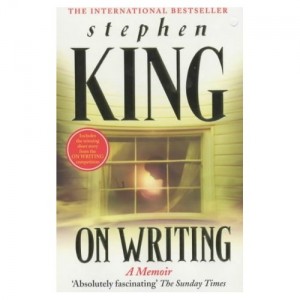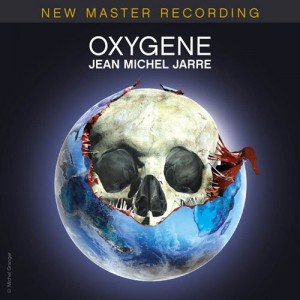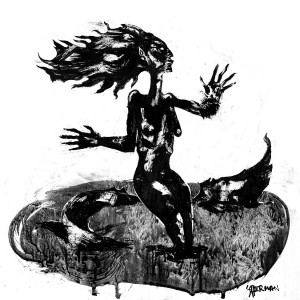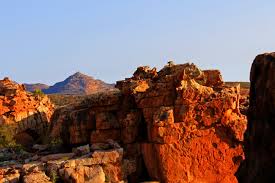‘V’ The Original Mini-Series (incl. V: The Final Battle)
*** WARNING: SOME SPOILERS AHEAD ***
From the dreary, droning soundtrack and the contrasting credits that flash up to flag each actor/actress we’re about to see (delivered in typical Dallas or Dynasty style), one could be forgiven for not expecting much from the original ‘V’ mini-series. It appeared seemingly out of nowhere on a Monday night at the start of the children’s summer holidays, on 30th July 1984 here in the UK. The two-part mini-series, called simply ‘V’ was shown on Monday and Tuesday, and was followed by the three-part sequel V: The Final Battle on Wednesday, Thursday and Friday – a five-day extravaganza of sci-fi drama and action the like of which hadn’t really been seen on British TV before.
I was just fourteen at the time, and while I don’t recall the exact details of the broadcast, I do know it was on ITV every evening of the week, with a break in the middle for the News At Ten (which Dad always watched). And after being allowed to stay up and watch the first one (again, with Dad), my world irrevocably changed…
It would be another four or five years before Star Trek: The Next Generation would be unleashed on the world, and ten years or so before Deep Space Nine appeared, so at the time this was the closest thing you could get to anything approaching big budget spaceships and aliens on TV, or at least, that’s how it felt at the time – needless to say the show itself doesn’t hold up to close scrutiny nowadays. Previous to this, I’d been an avid viewer of Battlestar Galactica (and its terrible sequel, Galactica 1980), Buck Rogers in the 25th Century, Logan’s Run and several other ‘future/space’ shows, and both Blakes Seven and Dr Who had long since dropped off my radar (esp. once Tom Baker left the latter), so other than Knight Rider, there was very little ‘bells & whistles’ TV available for an impressionable kid of the early 1980s when this came to our screens.
‘V’ taught me many things, and introduced me to many more – and all of them in the same week, but let’s not get ahead of ourselves…
A quick summary first. In brief, visitors come from outer space claiming to be on a mission of peace, they park their huge mega-spaceships in the air above all the major cities, appear to be similar to humans and proceed to ingratiate themselves into all the major communities of the world. They apparently need some of Earth’s resources, and through elaborate machinations involving a bogus ‘scientist’s revolt’, end up enforcing a state of fascistic martial law on the entire planet while they carry out the systematic draining of its main resource: water. They also want to use humans for food, and turn them into soldiers for a war that’s rarely referenced later in the series, but that’s another story. To the surprise of no-one, it was an allegorical tale recalling the Nazi occupations of 1939 and even the stylised Visitor badge/logo is reminiscent of a Nazi swastika.
The Visitors badge and logo appeared prominently throughout the series,
the similarities to the swastika have been well-documented since.
Back then I was oblivious to any of this, every part of me transfixed and filled to bursting by all the amazing guns (“Even that Daniel kid has one, Dad!”), the huge motherships and smaller shuttle craft, the incredibly pretty alien leaders (most of them blonde), the true reptilian nature of the aliens underneath their soft-skinned human exterior, the action scenes, the alien baby (called the Star Child of all things), everything about the show in fact – my wide-eyed, innocent younger self had never seen anything like it, and I firmly believe this series alone shifted the goalposts as to what could be seen at home on your own TV without venturing out to a cinema. Consequently, it also shaped my own expectations as to what incredible worlds and universes an active imagination could transport you to, and an appreciation of those same worlds that could be created for the entertainment of others without ever having to leave the planet.
I started taking more active interest in what books and comics I wanted to read shortly after this series aired, decided I wanted to be an astronautical engineer when I was older (that didn’t happen), and also discovered roleplaying games for the first time; and all this because I wanted to pilot a spacecraft and defend the human race, just like our heroes Mike Donovan and Dr Julie Parrish seemed to do.
Alas, many dreams and wishes of youth never really came to pass, but I have remained hooked on science fiction (and fantasy) books ever since, and this proved the founding stone that kick-started a lifetime’s interest in discovering other worlds of the imagination. I did manage to branch out into editing fanzines in later years (incl. Dark Elf, Eh?, Cerebretron and Sierra Heaven), and reading some horror and mystery/thrillers too, but the latter have never really held quite the same appeal.

It’s hard to put my finger on just why I have such abiding memories of ‘V’, but the iconic scenes throughout are probably a big part of it, and many of them tinged with humour too:
seeing a granny throw a Molotov cocktail into a shuttle craft showed me that even old people could be rebellious; watching one of the busty female visitors strip to her underwear probably left an altogether different type of imprint on me, I suspect (“You sure don’t look like an iguana!” remarks our hero, Mike Donovan); the crazy acrobatics of the small shuttle as Mike makes his maiden flight as a space pilot showed me that even heroes could get it all wrong; the hopelessly poor aiming throughout the series (seemingly alien and human alike were all terribly bad shots) taught me how TV makers could maintain interest by stretching fight scenes and keeping multiple flashes of laser-fire on the screen at the same time; the powerful female characters throughout showed me that women could be just as badass as men in real-life … the list of youthful influences goes on. There were many things in the show that were there simply to be enjoyed as part of the overall visual extravaganza, but once again back then a lot of the underlying message and meaning was lost on me (and truth be told, probably doesn’t bear up to thorough scrutiny now) – lost that is, in a haze of gun battles, explosions, attractive women leaders, and of course, green reptilian-like aliens…

This is one of the many symbolic images that defined the series. The smiley face of the
Visitors sits comfortably alongside the little reptile you’ll uncover once you start digging…
And then there was that iconic scene when Diana, the ruthlessly ambitious alien science leader, swallows a live guinea pig in one gulp just before the credits rolled on part one… this alone remains a memory forever seared into my soul – despite appearances, aliens were not very nice people, and TV producers could be absolute buggers when it comes to leaving viewers begging for more…
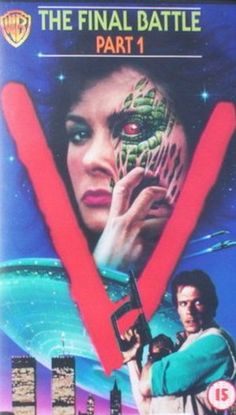
Things didn’t let up after the two-part mini-series, either, with V: The Final Battle proving –in three parts – just as chock full of iconic scenes and grisly drama: the uncovering of leader John’s reptilian skin beneath his face was broadcast across all TV networks, making us feel like we finally had a chance against the visitors (listen to me, us and we he says…); Mike Donovan’s mother shooting at her own son was a sure sign that she was beyond redemption. Similarly, there was the come-uppance of that traitorous little blighter, Daniel – yes, he shot our beloved Ruby, captured our heroine Julie, and was generally an irritable little twerp throughout – but the bullying lapdog did at least get what was coming to him: I couldn’t have been the only one who cheered when he was led off to be served on a silver platter for his former masters… Yup, another rock solid fist-in-the-air from my younger self!
But there was still more: the iconic birth of the twins: one normal-ish (albeit with a forked tongue, aka The Star Child), the other as green and slimy as you like; watching Diana’s truth serum in action as Mike is forced to reveal his green-skinned spy-cum-collaborator, the remarkably deadpan Martin; seeing the spandex-clad Julie and also that famous Dr Whatsisname experience the dreaded conversion chamber taught me that cream-nude was a colour that could never catch on… then there was the somewhat OTT death scene for that poor defenceless little green devil-twin while the ‘normal’ Star Child shed one skin after the next, growing so fast that we all knew she was evidently having more than the famed three shredded wheat that no-one else could manage according to the TV ads of the time… 😉
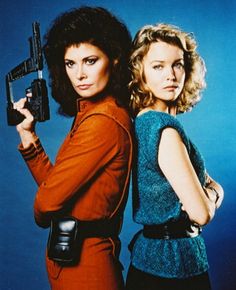
Other notables: an ex-army priest carrying a gun everywhere he went, and that same priest being so hopelessly misled by his unerring faith in God that he brings the Star Child to Diana along with his trusted bible, it’s hardly surprising when Diana’s take on the bible proves somewhat at odds with his own lofty expectations.
Ahhh… the little green alien thingy… We were supposed to go teary-eyed when this blighter snuffed it…
Yeh, there was hammy acting, and even hammier dialogue, and plenty of blossoming relationships that were bound to end on the trash-heap, with your typical “we’ll get married after this”-type scene resulting in at least one or the other being disappointed after the next raid. That said, the stumbling relationship between Harmony and the hapless, clumsy Willie (Robert Englund aka Freddy Krueger playing a painfully shy alien) could probably be considered a roaring success compared to the fate that befell visitor poster-boy Brian and the seemingly innocent Robin – yes, they begat the Star Child and the green thingy between them, but responsible parenting stopped when Robin decided to use Brian as a guinea pig while her daughter looks on…
‘V’ also showed me how people could deceive those they love yet still remain at heart good people, it showed me how even bad evil aliens could have a good side, and it also showed me the flipside of human misery and suffering in all its glory, and therein lies the rub, because it’s clear throughout the series that humans could also be very nasty indeed: selling each other out to the visitors at the drop of a hat, backstabbing their own for a brief slice of recognition, lauding it over those in less fortunate circumstances, the dread consequences of misplaced hope, trust and belief… The whole gamut of human weakness gets an airing, our moral frailties exposed again and again throughout, and at the heart of it the knowledge that none of this is real, yet deep down it is just that: it’s all too real and has already happened in one form or another in our past, whether or not people still choose to believe it.
Yes, a remarkable pair of mini-series was ‘V’ and V: The Final Battle, but all the moreso for an awkward, spotty teenager who struggled to find a place for himself between the cool footballers of the school and the smarty-pants nerdy-types (I was very good at football yet smart enough to hang with the nerds, too) – it looks like the nerds may have won that one, though, or lost it, depending on your point of view… 😀
SOME HANDY LINKS TO CHECK OUT:
Link to IMDB entry: http://www.imdb.com/title/tt0085106/
Link to short V summary vid (recapping the first episode: 2 min warning!): https://www.youtube.com/watch?v=M77HfZu24bw




